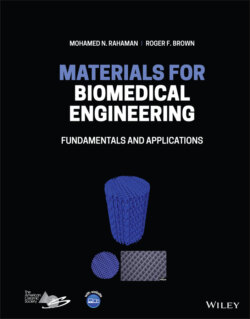Читать книгу Materials for Biomedical Engineering - Mohamed N. Rahaman - Страница 94
3.4 Defects in Crystalline Solids
ОглавлениеA perfect crystal is an idealization. Imperfections, often called defects, are present at random positions in the structure. These defects play an important role because they control several physico‐chemical properties of the solid. Metals, for example, would not show the attractive mechanical property of ductility when subjected to an applied stress were it not for the presence of a particular type of defect in the crystals called dislocations. Defects in crystals occur for two main reasons. Structurally, atoms in the pure material do not pack perfectly in a crystal due to thermal fluctuations during their processing or growth. Chemically, other atoms can be added accidentally or deliberately during production of the material, which disrupt the regular‐repeating pattern of the host atoms. As this type of compositional modification can influence the defect structure to a far larger extent than purely packing irregularities in the pure material, it is a widely used approach to modify or improve the properties of metals and ceramics.
Defects in crystalline solids are commonly divided into three types, described as point defects, line defects, and planar defects. Three‐dimensional defects, such as microcracks, pores, and fine particulate inclusions can be accidentally incorporated into a solid, whether crystalline or amorphous, during its production or use. These three‐dimensional defects have a significant effect on the bulk properties of a solid, such as its strength and the way it fractures under an applied mechanical stress (Chapter 4).
